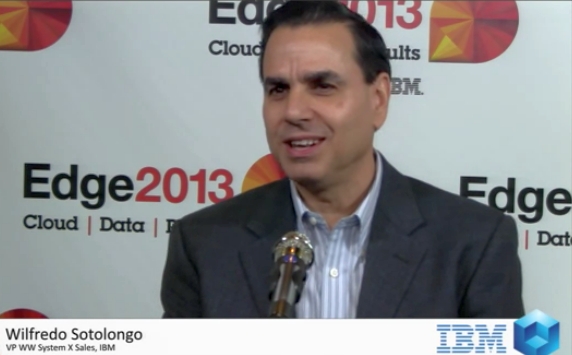 NEWS
NEWS
 NEWS
NEWS
 NEWS
NEWS
![]() Dave Vellante with co-host Steve Kenniston (Global Storage Evangelist with IBM), interviewed Wilfredo Sotolongo, IBM VP of WW System X Sales, during theCUBE’s live broadcast at the recently concluded IBM Edge 2013 event.
Dave Vellante with co-host Steve Kenniston (Global Storage Evangelist with IBM), interviewed Wilfredo Sotolongo, IBM VP of WW System X Sales, during theCUBE’s live broadcast at the recently concluded IBM Edge 2013 event.
Sotolongo was one of the first decision makers on expanding Edge beyond Storage, to bring into the market place the way IBM’s customers are buying. While sometimes that is solution- or product-specific, most of the time it’s more of a cross-brand or a cross-technology approach. Seeing this event the way it unfolded today gave Sotolongo a great deal of personal satisfaction.
Diving into the metrics of the business, Wilfredo Sotolongo thinks he’s identified four distinctive patterns regarding customers’ buying habits. On one hand, there are the extremist customers:
In between those extremes there are two categories that Sotolongo takes avid interest in, due to his business:
So the four patterns are: the self-integrator (aka the piece-parts buyer), the reference architecture buyer, the integrated-solution buyer and the business-process buyer.
There has been a shift in the percentage of these types of buyers. Four years ago it was 60-40 for the first two types opposed to the last two. These days the percentage is a bit more balanced. The first two types (extremists) constitute a third, the third type (more flexibility) makes up a third, and the last type (fully-configured) makes up the last third.
The people at IBM must also shift their minds as they develop new products and create solutions.
Vellante wanted to know exactly how much flexibility is in the reference architecture and what was IBM’s strategy regarding flexibility. Sotolongo explained that IBM is approaching reference architecture from the customer’s point of view. They start by doing market research regarding top solutions in the marketplace. Then they look for the most popular, enabling them as well in the reference architecture. They enable their own products and the products of their competitors.
Just to prove that you never know it all in the business, Sotolongo admitted they were totally blind-sided by the desire of their clients to self-integrate. Who knew they were going to prize their “independence” so much? But they did.
Kenniston agreed, putting himself in the shoes of the business owner who sacrifices financial savings and picks software that can help him better manage his business and his growth. When building his architecture, it’s not always about the hardware.
Vellante asked about IBM’s position on the Channel, and the message to key Channel partners. Sotolongo clarified that the Channel is not a global business, but a local one. Some distributors may develop global businesses, but they still operate locally. The marketplace is substantially different in North America than from the rest of the world, because of regulatory norms, taxes or local laws. There’s a high dependency on The Channel outside the U.S., despite its lack of maturity. However, it is a critical and stable component, explains Sotolongo. In the U.S., the Channel is quite mature and developed, and engaged in quite a war for talent.
Support our mission to keep content open and free by engaging with theCUBE community. Join theCUBE’s Alumni Trust Network, where technology leaders connect, share intelligence and create opportunities.
Founded by tech visionaries John Furrier and Dave Vellante, SiliconANGLE Media has built a dynamic ecosystem of industry-leading digital media brands that reach 15+ million elite tech professionals. Our new proprietary theCUBE AI Video Cloud is breaking ground in audience interaction, leveraging theCUBEai.com neural network to help technology companies make data-driven decisions and stay at the forefront of industry conversations.